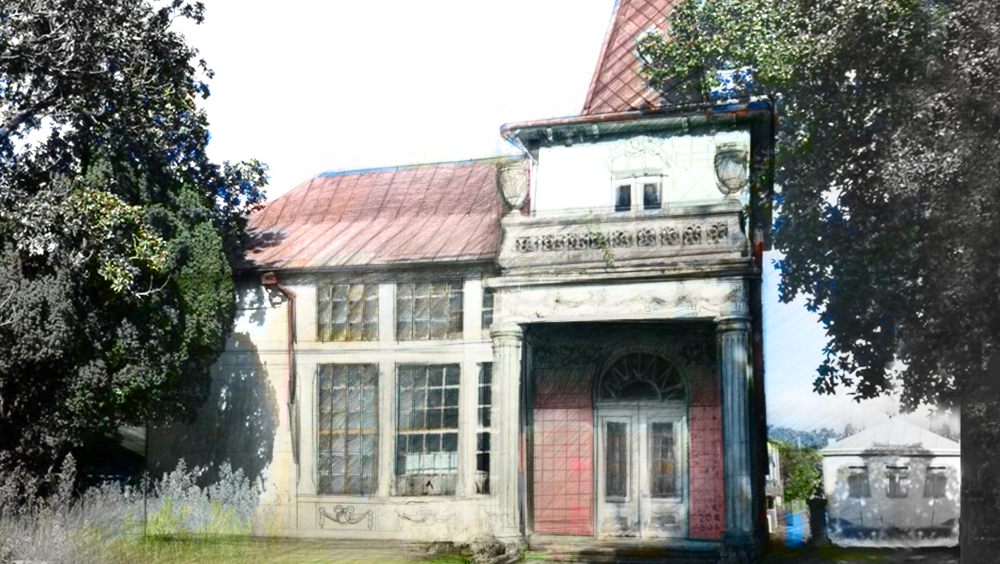HOUSE MANIFESTO
Effendi Villa, a grand historic house dating back to the turn of the 20th century, is located on the coast of the Black Sea near the Lesser Caucasus Mountains in the town of Kobuleti, Georgia. Effendi Villa has always united the cultural diversity of the region under its roof. Built by Italian architects, it has housed noble people from Georgia, Russia, Turkey, Great Britain, Romania, and Sweden. The villa is proudly held in the collective memory of the Kobuleti community, as an icon of local identity and the diverse history of a region which was under the influence of Ottoman and Russian Empires for many centuries. Today, a team of civil actors has been reviving Effendi Villa to establish a community and visitor centre, a physical space for community and capacity building, conflict resolution training, human resource development, social entrepreneurship and local identity marketing.
Since the turn of the 20th century, I have been standing on the coast of the Black Sea near the Lesser Caucasus Mountains a bit north of the Turkish border in the town of Kobuleti, Georgia. Arguably, I am the most photographed - and the most stunning - late neoclassical historic building in the town of Kobuleti. Why? Locals and tourists will point to my Greek porch entrance and exterior decorated with griffins and mystic ornaments. But I am more than meets the eye of a casual observer on the street. I was commissioned by the famous public prosecutor of Georgia, Basil Effendi. If you’re curious, that bold letter "E" above my front balcony stands for Effendi. Understandably, they call me Effendi Villa. Once I was the opulent summer home of a noble family. In my heyday, I stood proudly on 10 acres, and the family horses rested on my grounds while exotic species such as peacocks and guineafowl walked around and boasted with their beauty. The alliance of Mr. Effendi, a Turkish-Romanian noble man and Lidia Dumbadze, a daughter of the Dumbadze family who made a prosperous oil business with Branobel company in Baku, Tbilisi and Batumi, led to an extended family that lived happily with me until the communist regime came to power in Georgia in the 1920's. Some family members were exiled or executed; others managed to emigrate to Great Britain and Canada where a few relatives of the Effendi family still live. Only the youngest daughter escaped from the terror, saving my life as well as her own. I wasn’t completely immune to the changing times. Due to the social and charitable activities Lidia and I implemented, I was not destroyed or nationalized. Between 1930 and the 1960’s I hosted a local primary school. My heiress herself taught children subjects including Math, Literature, Art and many others. There are still people alive who went to that school and remember my beautiful interior richly decorated with mouldings, paintings and sculptures. I was designed exclusively by Italian architects, an extremely rare occurrence today. The construction documents have it that my walls are covered with cladding tiles brought from France; floors are decorated with linoleum produced by “Vikander and Larson Co” in Riga, Latvia; paintings, furniture and accessories – all made by fashionable European masters and brought to Kobuleti by sea. That’s just one aspect of my distinguished pedigree: I am a late example of neoclassical architectural style, if you could not tell from the ornamental details, multiple windows, hip-roofed cupola peeking above my roof line. Much like the murals, my history is not immediately apparent from the Greek porch with Doric columns that forms my facade. But ask around Kobuleti, and it will not be too long before you find a local with some kind of connection to me. The place I hold in the collective memory of Kobuleti community has not disappeared, even after years of conflicts and wars in the region, national reforms, and collapsing ceilings of the building. Kobuleti never forgot about me, though. I was honored to be added to the National Register of Historic Monuments of Georgia in 2008. Those 10 acres are now occupied by the other lovely homes that make up my neighborhood, but my lot is still one-quarter of one. Although I’m less lonely than before, my Italianate details can’t be outdone, and I remain the neighborhood and town’s landmark. Although my gravitas comes from my storied past, I have aged gracefully. Sincerely Yours, Effendi Villa 568, Agmashenebeli St., 6200 Kobuleti, Georgia
The region of Adjara, Georgia has been a crossroads for diverse cultures and religions, including Christianity, Judaism, and Islam. This region has also been of great political interest for countries such as Turkey, Russia, England, Germany, Romania, Sweden and France. Residents of these countries moved to the region of Adjara and settled there in the 19th century and the beginning of the 20th century. They also brought and spread their religious and cultural heritage in the region. Nowadays, one can still find traces of the colonial period in Adjara in architectural monuments and buildings such as Effendi Villa. Effendi Villa is the only existing monument to the turn of the 20th century history, architecture and everyday life of a Georgian-Turkish-Russian-Swedish-Romanian noble family in the town of Kobuleti. The cultural heritage site is considered part of the European heritage due to its unique history, neoclassical architectural style and distinguished owners and guests of the house. Known for its rumored connection to the famous Nobel Brothers, whose house was not far away, Effendi Villa started life as the home and meeting place for businessmen, bankers and state officers at that time. Mr. Effendi was a shrewd and intelligent person who had a lot of wealthy noble friends. The Social Impact Hub hosted by Effendi Villa aims to foster social integration and cohesion in the region by implementing cultural and educational projects as well as programmes on the process of Georgia’s European integration.
